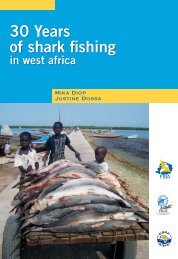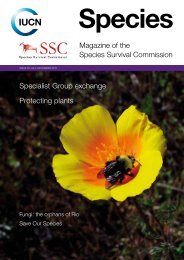Kyne & Simpfendorfer.. - Shark Specialist Group
Kyne & Simpfendorfer.. - Shark Specialist Group
Kyne & Simpfendorfer.. - Shark Specialist Group
Create successful ePaper yourself
Turn your PDF publications into a flip-book with our unique Google optimized e-Paper software.
SECTION II.<br />
LIFE HISTORY OF DEEPWATER CHONDRICHTHYANS<br />
Introduction to the life history characteristics of chondrichthyans<br />
The chondrichthyans are generally considered to be K-selected species, displaying<br />
conservative life history parameters such as relatively slow growth, late age at maturity, low<br />
fecundity and low natural mortality (Hoenig and Gruber 1990, Musick 1999). This results in a<br />
limited reproductive output, putting their energy into a few well-developed young which<br />
resemble miniature adults at birth. As such, the productivity of many chondrichthyans falls<br />
within the range of other long-lived animals, such as many large mammals (Cahmi et al.<br />
1998), and is in contrast to r-selected species whose life history strategy is to produce large<br />
numbers of offspring with a limited lifespan (Hoenig and Gruber 1990). The restricted life<br />
history characteristics of the chondrichthyans place them at risk of overexploitation and<br />
population depletion, with an inability to recover from reduced population levels once<br />
depleted. This vulnerability is generally heightened in the deepsea, a relatively stable, cold<br />
water environment where food resources are more limited. Subsequently growth rates are<br />
slower and recruitment to the population is reduced.<br />
An understanding of several biological parameters is important to accurately assess the<br />
productivity of an individual species and thus make inferences concerning its vulnerability to<br />
fisheries. These parameters include size and age at maturity, fecundity, longevity and<br />
reproductive periodicity. For the vast majority of deepwater species, this data is lacking,<br />
highlighting a significant gap in our knowledge base. Section II of this report collates<br />
available (published and unpublished) information on the life history of deepwater<br />
chondrichthyans and provides an assessment of the productivity of the group.<br />
Provided here are brief introductions to the reproductive biology and age and growth of<br />
chondrichthyan fishes, including basic methodological backgrounds to the information<br />
provided in the life history accounts which follow. Methods for undertaking the assessment of<br />
the productivity of deepwater chondrichthyans are provided at the beginning of that<br />
assessment.<br />
In all chondrichthyans, fertilization is internal although they display a diversity of<br />
reproductive modes. The terminology of reproductive modes and the descriptions following<br />
are taken from Musick and Ellis (2005). In oviparous species, egg-laying can be either single<br />
oviparity (a single egg case deposited from each oviduct) or multiple oviparity (multiple egg<br />
cases retained in the oviduct for an extended period of embryonic development before<br />
laying). In viviparous chondrichthyans, the most basic form is yolk-sac viviparity where<br />
fertilized ova develop in utero, and the embryo obtains nutrition from a single yolk-sac. This<br />
form of viviparity together with both forms of oviparity are considered lecithotrophic modes<br />
of reproduction, whereby there is no additional maternal nutritional input other than that<br />
provided in the ovulated egg. The vast majority of the deepwater fauna is lecithotrophic<br />
(oviparity or viviparous forms). The remaining reproductive modes are matrotrophic,<br />
whereby embryos rely on additional maternal nutritional input for at least part of their<br />
development. The matrotrophic modes are histotrophy (embryos obtain nutrition from a<br />
histotroph or 'uterine milk' secreted by trophonemata in the maternal uteri), oophagy<br />
(embryos subsist on unfertilised ova ovulated by the mother; this includes the advanced form<br />
known as adelphophagy whereby one embryo in each uterus feeds on its sibling embryos<br />
63
















